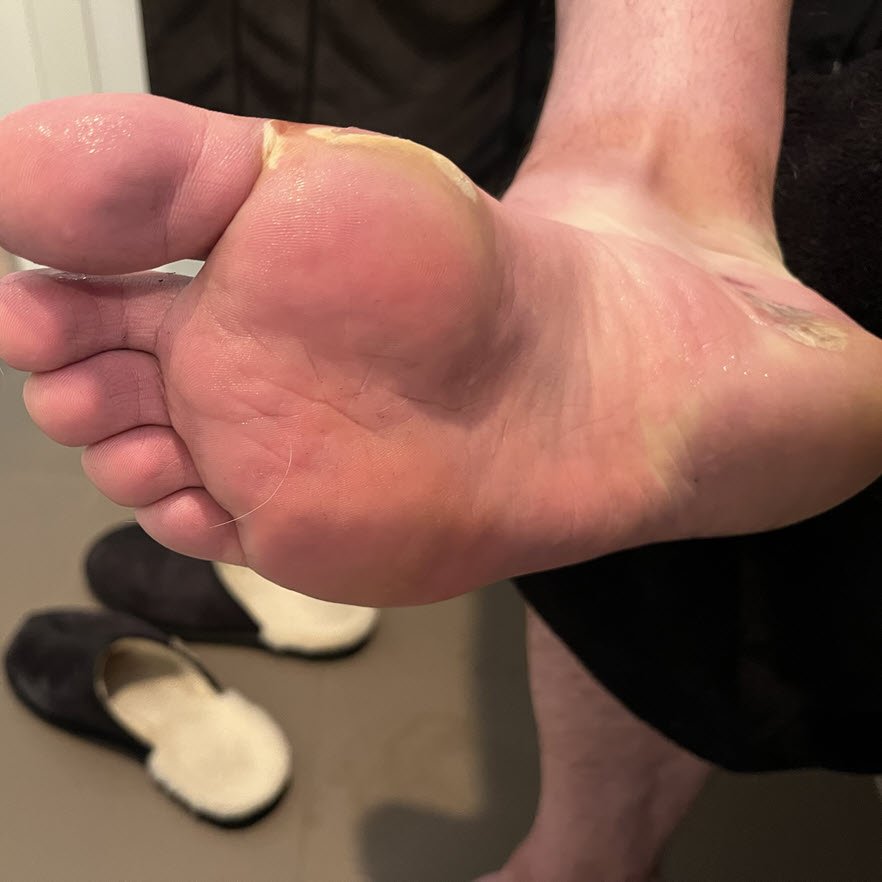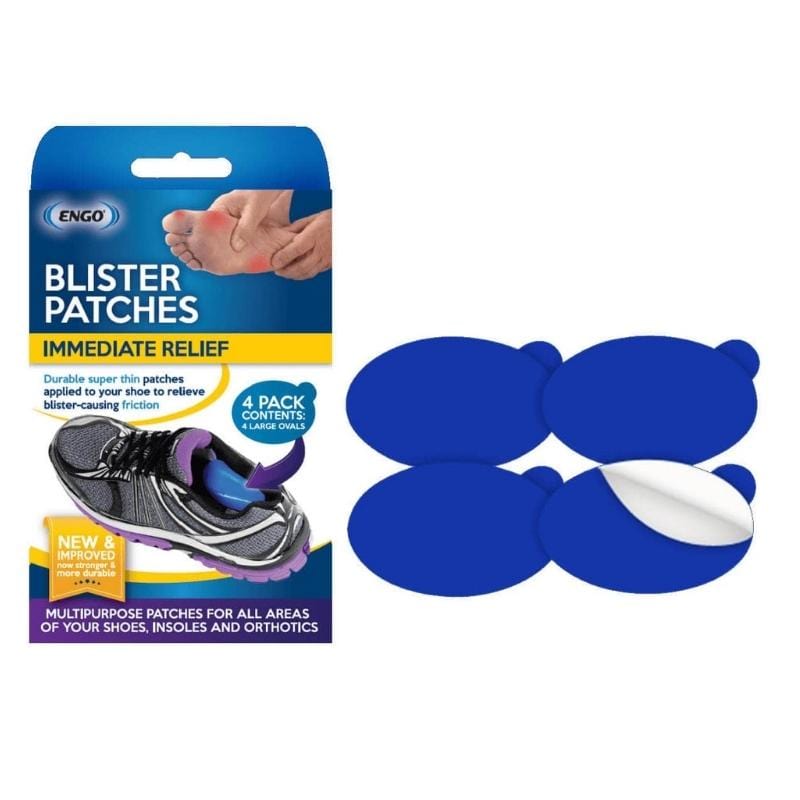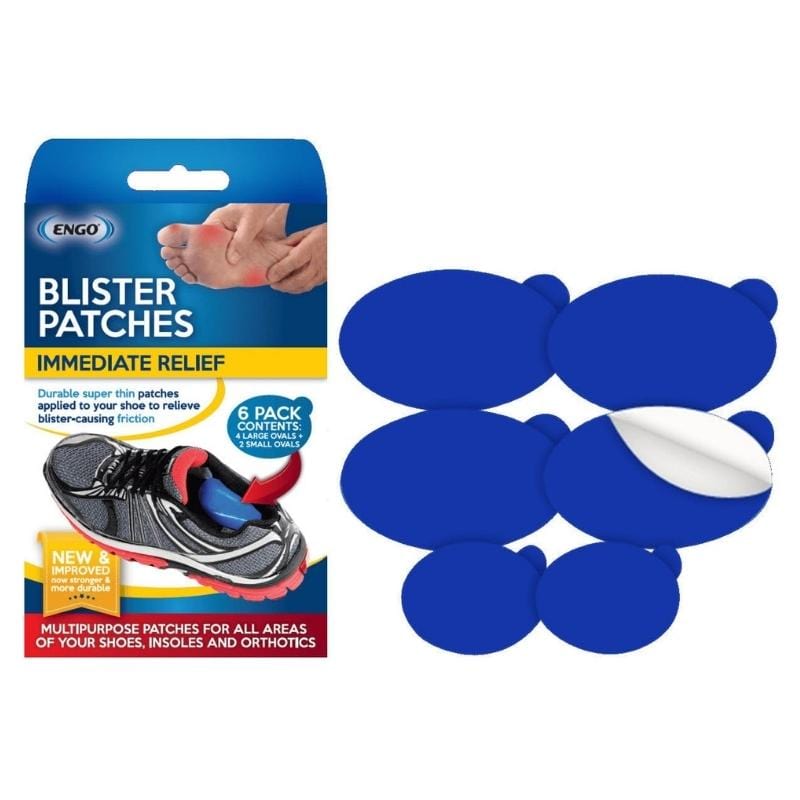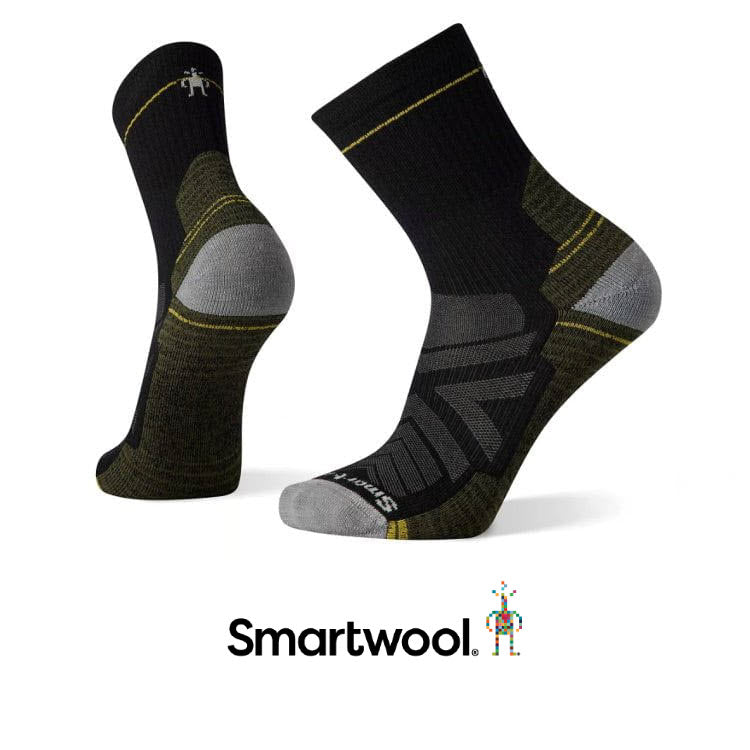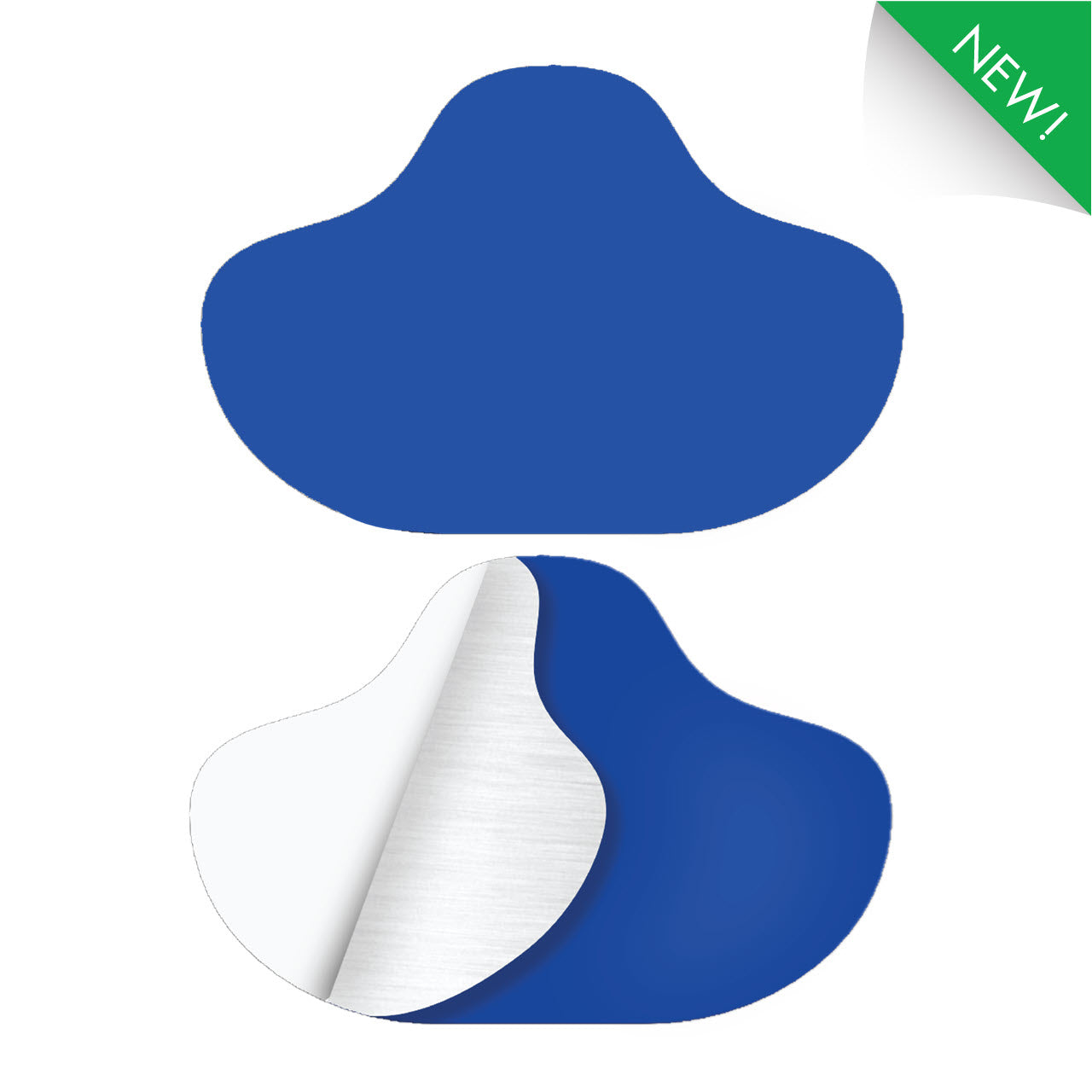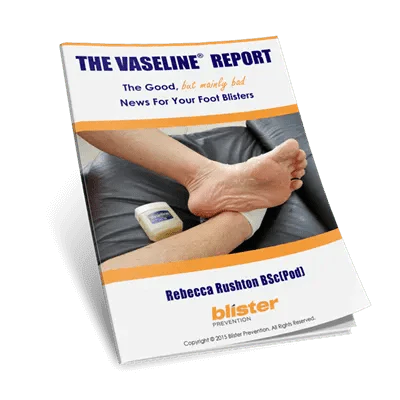Some people sweat more than others. But there's an extreme sweating disorder called hyperhidrosis where the body’s sweat glands are especially overactive. It can leave you dripping with sweat for no apparent reason. This can present as excessively sweaty feet, hands, under-arms, face, scalp or even the whole body. If you sweat excessively, this article is an overview and has a lot of links to authoritative websites and organisations where you can learn more. This photo is from a runner training for a marathon. You can see he's got a few edge blisters we're dealing with.
Can you see the perspiration beading on the skin?
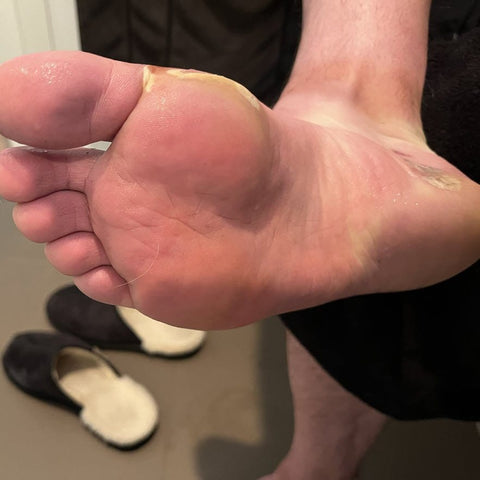
Why Do Our Feet Sweat?
Sweat is produced by the eccrine sweat glands. We have eccrine sweat glands all over our body but they are particularly numerous on our palms and the soles of our feet. Each foot has approximately 125,000 sweat glands - that's about 700 glands per square centimetre.
Sweating is a normal bodily function. It's how your body cools itself to regulate body temperature. Nerves tell your sweat glands to kick into action; slightly salty water is released to the surface of your skin; that water evaporates and this cools the skin surface.
Specific to the palms and soles, sweating is advantageous as moisture increases friction levels. This helps when gripping things, and it helps to give your feet traction in your shoe or on the ground.
Sweating occurs during exercise and when we get hot. But sweating episodes are common when we're sick and when we're nervous or scared (think fright or flight).
However, in hyperhidrosis, sweat glands work overtime for no apparent reason, producing sweat that you don’t need. The medical definition of hyperhidrosis is excessive sweating without any provocation.
What is Hyperhidrosis?
Hyperhidrosis is defined as perspiration beyond the level required to maintain temperature regulation. It affects 3 - 5% of the US population, depending on which resource you're looking at . Some publishers say more males than females suffer with it; others say it's about 50% male, 50% female.
Types and Causes of Hyperhidrosis
There are two types of hyperhidrosis:
- Primary (or focal) hyperhidrosis is excessive sweating of the feet (plantar hyperhidrosis), hands, underarms and face for no apparent reason. It usually begins in childhood or adolescence and sometimes runs in families. Interestingly, people with primary hyperhidrosis rarely sweat when they are asleep.
- Secondary (or generalised) hyperhidrosis is excessive sweating over larger areas of the body, or the whole body. There is usually a reason like a medical condition or as a medication side-effect. Sweating while sleeping is common. Secondary hyperhidrosis begins in adulthood.
Symptoms of Plantar Hyperhidrosis
Well, apart from having wet feet, socks and shoes, your skin that sweats excessively is often cold. As the perspiration evaporates, it cools the skin surface. This is more noticeable on the hands as they are more open to the air; as opposed to the feet when they are covered in socks and shoes.
How is Plantar Hyperhidrosis Diagnosed?
A preliminary diagnosis of hyperhidrosis can be established on symptoms alone. But as you can see from the above, there are medical and genetic reasons for excessive sweating. As such, a visit to your doctor is warranted. The cause will very much determine the treatment. There are three tests that can be used to quantify excessive sweaty feet:
- Starch-iodine test: Iodine solution is applied to the soles of your feet and starch is sprinkled over the iodine solution. Excess sweating turns a dark blue colour.
- Paper test: Your feet are placed on a special paper which absorbs sweat. The paper is weighed and this shows how much your feet have sweated.
- Infrared thermography: Excessive sweating leads to reduced skin surface temperature due to evaporation. A thermal camera can measure temperatures and confirm the diagnosis of hyperhidrosis, used mainly for the palms of the hands (palmar hyperhidrosis).
Can Plantar Hyperhidrosis Cause Other Problems?
Apart from the frustration and discomfort of having sweaty feet, plantar hyperhidrosis can cause a number of issues due to the excessive moisture, including bacterial and fungal infections:
- Fungal infections - Tinea, also known as athlete's foot, thrives in moist conditions. You can learn more about tinea management here.
- Pompholyx - Also known as vesicular dermatitis, this type of eczema is characterised by multiple small blisters. Learn more about pompholyx here.
- Foot odour - Sweat is odourless. It's mainly water with a tiny bit of salt content. But sweat can contribute to foot odour when bacteria are added to the equation. Bacteria consume sweat to produce an odour. Pitted keratolysis is a condition associated with hyperhidrosis and a bacteria called corynebacteria. Apart from treating the hyperhidrosis itself, antibacterial soap or medications can take the bacteria out of the equation. You can learn more about pitted keratolysis here - there are some great photos that will help you determine if you have this condition.
- Friction blisters - Sweaty feet increase your chance of getting foot blisters. More moisture means higher friction levels, which basically means everything's just stickier. We call this stickiness a high coefficient of friction (COF). And because the moisture is coming from the skin and soaking into the sock, we're talking about the skin-sock interface.
- Learn more about what causes friction blisters here
- Learn more about moisture-wicking socks here
- Maceration - Maceration is a severe form of waterlogged skin. While it might look a lot like blisters, it's quite different. The skin is very weakened. Prevention is paramount. You can learn more about maceration here, including maceration treatment and maceration prevention.
Plantar Hyperhidrosis Treatment Options
The basics of foot hygiene like trying to keep your feet dry will help you manage odour, infection and general discomfort that can come with having clammy, soggy feet. However, there are a number of effective treatments for plantar hyperhidrosis that can significantly reduce excessive perspiration:
1. Antiperspirant with high aluminium content
Antiperspirants containing aluminium salts produce a chemical reaction that forms plugs in the eccrine sweat ducts .
- Over-the-counter antiperspirant: A clinical strength antiperspirant containing 20% aluminium chloride is a good place to start to reduce foot sweating. Examples include Driclor and Rexona Clinical Protection. You can get these over the counter at a pharmacy, no prescription required. These antiperspirants work best when used at night before you go to bed.
- Prescription antiperspirant: Stronger antiperspirants may be available on prescription. However, such antiperspirants are more likely to cause skin irritation. We've talked about the skin irritation that can come from strong antiperspirants used for blister prevention here.
2. Iontophoresis
You doctor or dermatologist may recommend a technique called iontophoresis for plantar hyperhidrosis. Iontophoresis is basically a shallow foot bath with an electrical current passed through it. Sounds uncomfortable, but as the video on this page shows, it's quite benign. And more importantly, often very effective. Iontophoresis is thought to either interfere with the function of eccrine sweat glands that produce sweat, or block sweat ducts. It will reduce sweaty hands and foot sweating but its effect wears off so treatment is ongoing. Home kits are available as you have to use this treatment frequently. You can learn more about iontophoresis for hyperhidrosis here. and here.
3. Botox injections
Botox blocks the neurotransmitter that tells the sweat glands to activate. It takes 1-2 weeks for the treatment to take full effect. Botox is not commonly used for plantar or palmar hyperhidrosis - it's used almost exclusively for axillary (armpit) hyperhidrosis. Its effect is temporary, lasting around 6 months before further injection is required. You can learn more about botox injections for hyperhidrosis here.
4. Anticholinergic medication
Anticholinergics are topical or oral medications that work systemically to block the transmission of the chemical messenger (acetylcholine) responsible for excessive sweating. You can learn more about anticholinergic meds for hyperhidrosis here. There can be side-effects including eg: dry mouth, constipation, impaired taste, blurred vision and problems urinating. However, fine-tuning to dosage can keep these to a minimum whilst maximising the beneficial effects.
5. Radiofrequency, microwave and laser therapies
Energy-based devices all use heat to destroy sweat glands. It seems evidence is limited at this stage and they are used mostly for the underarm area. But the thought is their effects may be permanent as once the glands are destroyed, they do not regenerate. You can learn more about energy-based devices for treating hyperhidrosis here but be sure to consult with a dermatologist for the most up-to-date information.
6. Sympathectomy
A sympathectomy is an endoscopic surgical procedure where the nerves that control sweating are cut. Two reports indicate a 90% improvement in symptoms for those who sweat excessively with this procedure for palmar hyperhidrosis. It's not often performed for plantar hyperhidrosis. However, it can cause other serious problems and the procedure is considered in severe cases as a last resort. You can learn more about surgery for hyperhidrosis here.
Hyperhidrosis and Blister Prevention
What Shoes Are Best?
The more breathable, the better. You want to allow sweat to evaporate through your shoe upper. As such, mesh joggers are much better than leather upper joggers. Same with boots - choose materials that aid evaporation through the upper. Obviously, this can be tricky if your job requires leather work boots or rubber boots. I live in a farming and mining area and so a lot of my patients are in this situation. There's no magic solution here. But it's a good idea to let that shoe dry out overnight before wearing it again next day. Consider taking the insole out overnight to facilitate this - because it has absorbed a lot of sweat all day. You could even have 2 pairs of insoles and alternate them each day. Why not washing the other out and giving it a whole extra 24 hours to fully dry before wearing it again.
What Socks To Wear?
There's no clear answer to this seemingly basic question. A lot of resources say synthetic is bad and to only wear cotton socks. I'm not sure if this is good advice, knowing what we know about cotton and its moisture-management properties. Synthetic socks actually deal with moisture better, transporting it away from the skin surface, into the sock so it can hopefully evaporate through the shoe upper. This is called moisture-wicking and I've written about this previously. Wool on the other hand has the best ability to absorb moisture within its fibres, keeping it away from the skin surface itself. So, while I don't have definitive advice on this matter, there is little doubt that for someone with hyperhidrosis, the absorptive capacity of any sock material will soon be exceeded, rendering any moisture-wicking function useless at some point. Changing socks frequently is a good idea, albeit it inconvenient.
Should I Use A Powder?
In a word, no. If we think about how powders works, most of them (talc and starch powders) absorb moisture. That sounds good, but such powders can only absorb a small amount of moisture (13-17%) before they form a paste-like substance . And this paste ends up being abrasive. However, 2Toms Blistershield powder is quite different in that it isn't a talc or starch powder and it doesn't absorb water. It's made of PTFE and is markedly hydrophobic. While it will disperse into the sock over time, and therefore require reapplication, at least it won't increase friction levels. So if you want to use a powder, use 2Toms Blistershield powder.
Will ENGO Blister Patches Work with Hyperhidrosis?
Yes, they will. As long as your shoe is completely dry when you apply them, it won't matter how sweaty your feet are - the patch will remain stuck to your shoe or insole or orthotic. Purely for their longevity, I would choose ENGO Patches over 2Toms Blistershield powder as my preferred friction management strategy. No hourly/daily reapplication is required.
Tapes and Dressings
In the blister management world, we often use tapes to prevent blisters. And dressings to treat them. There are 2 things you should keep in mind here:
- If your tape or dressing won't stick because your skin is damp and continues to sweat excessively, use an adhesive-enhancer like Friars Balsam or Skin-Prep wipes.
- Most tapes and dressings are made from cotton or similar materials. As they absorb sweat they can make your skin soggy and even macerated. So:
- Consider if taping is the best blister prevention strategy for your blisters
- If you are taping, consider a very thin tape, like Fixomull Stretch - it won't hold as much moisture
- Change your dressings frequently and don't leave your tape on for any longer than you need to
Need more help with plantar hyperhidrosis?
If you'd like to learn more about excessive foot sweating or hyperhidrosis diagnosis and treatment more broadly, this UK website has a lot of great information. You can consult online with a specialist in hyperhidrosis here. Or of course, see your own doctor or dermatologist.
Academic References
- Pariser DM, Ballard A. Topical therapies in hyperhidrosis care. Dermatol Clin. 2014 Oct;32(4):485-90. doi: 10.1016/j.det.2014.06.008. Epub 2014 Jul 29. PMID: 25152341.
- Liu V, Farshchian M, Potts GA. Management of Primary Focal Hyperhidrosis: An Algorithmic Approach. J Drugs Dermatol. 2021 May 1;20(5):523-528. doi: 10.36849/JDD.5774.
- Connolly M, de Berker D. Management of primary hyperhidrosis: a summary of the different treatment modalities. Am J Clin Dermatol. 2003;4(10):681-97. doi: 10.2165/00128071-200304100-00003.
- Nawrocki S, Cha J. The etiology, diagnosis, and management of hyperhidrosis: A comprehensive review: Therapeutic options. J Am Acad Dermatol. 2019 Sep;81(3):669-680. doi: 10.1016/j.jaad.2018.11.066. Epub 2019 Jan 31. PMID: 30710603.
- Comaish S and Bottoms E. The skin and friction: Deviations from Amonton’s Laws and the effects of hydration and lubrication. British Journal of Dermatology. 1971. S4, 37: 37-43.
Take Moisture Out Of The Equation
Excessively sweaty feet means any blister product applied to your skin is likely to be less effective. The moisture will make it come unstuck, dissolve it or help it disperse away from where you actually need it. Instead, use ENGO Blister Patches that apply to your shoe, not your skin. Friction measurements have shown that no matter how sweaty your feet get, ENGO Blister Patches keep friction levels low. Their adhesion is unaffected by hyperhidrosis. Highly recommended!
